|
WRIGHT BROTHERS National Memorial |
 |
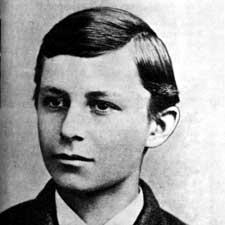 Wilbur Wright, about 1880. |
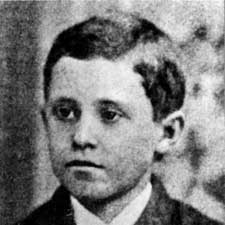 Orville Wright, about 1880. |
KITTY HAWK AND KILL DEVIL HILLS are American place names that will live in history. Here Wilbur and Orville Wright, two unassuming brothers with a passion for advancing aeronautical knowledge, and the willingness to undertake a scientific adventure, made the world's first successful flight of a man-carrying, power-driven, heavier-than-air machine.
December 17, 1903, was the day man first flew in this machine. It was a cold and windy day when Orville Wright climbed aboard their plane at 10:35 a.m. His first power-driven flight of 120 feet lasted just 12 seconds when he flew over a wind-swept stretch of level sand now preserved at Wright Brothers National Memorial. From those moments the science of aeronautics has borne the impress of the Wrights' achievements.
The Wright Brothers of Dayton, Ohio
The two young men who were to be the first to fly were born in the midwest shortly after the Civil War. Wilbur Wright was born on a farm near Millville, 8 miles east of New Castle, Ind., April 16, 1867. Four years younger, Orville Wright was born in Dayton, Ohio, August 19, 1871. They were the sons of Rev. Milton Wright, a minister, and later bishop, of the United Brethren Church, and Susan Koerner Wright. Both parents had been teachers. When his sons were small, Bishop Wright was editor of the church's publications. Mrs. Wright had "a streak of her father's mechanical ability," and she had a reputation in the family for being able "to mend anything." Bishop and Mrs. Wright also had two older sons, Reuchlin and Lorin, and a younger daughter, Katharine.
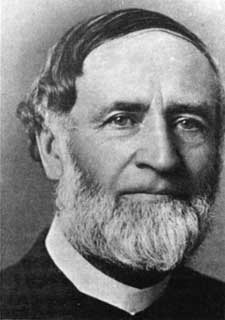 Bishop Milton Wright, 1889. The father of Wilbur and Orville, Milton Wright (1828—1917) was a bishop in the Church of the United Brethren in Christ. |
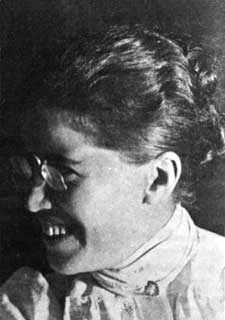 Katherine Wright, sister of Wilbur and Orville, about 1900. |
In the Wright home, children were encouraged to pursue intellectual interests and to investigate whatever aroused their curiosity. Wilbur and Orville displayed mechanical aptitude, the gift of original thinking, and a pioneering urge. Sharing a common interest in mechanical devices, the boys made kites and toy helicopters, built a lathe and a printing press that worked. Wilbur wrote of their close associations:
From the time we were little children my brother Orville and myself lived together, played together, worked together and, in fact, thought together. We usually owned all our toys in common, talked over our thoughts and aspirations so that nearly everything that was done in our lives has been the result of conversations, suggestions and discussions between us.
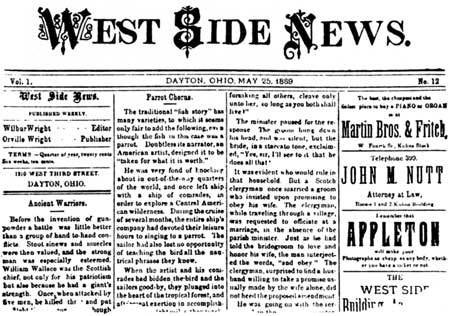
This successful neighborhood weekly was
published by Orville Wright on a printing press assembled from old parts
found in junkyards and barns. Wilbur Wright was editor.
Courtesy,
Smithsonian Institution, Washington, D.C.
Mrs. Wright died in 1889. It was that year that the brothers assembled their printing press from old parts found in junk yards and barns and began to publish a successful neighborhood weekly newspaper. Although each brother attended high school the full time required for a diploma, neither of them formally graduated from high school or attended college. Their two older brothers married and established homes of their own, but Wilbur and Orville remained bachelors. After completing their schooling they continued to live with their father and schoolteacher sister in a modest framehouse in Dayton.
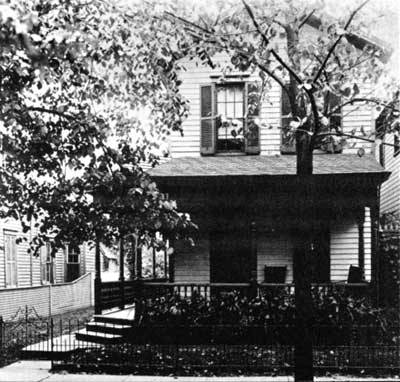
The Wright home, 7 Hawthorne Street, Dayton, about
1897, three years before the first Kitty Hawk experiments. The house
where Orville was horn in 1871, and where Wilbur died in
1912.

|

| History | Links to the Past | National Park Service | Search | Contact |
|
Last Modified: Sat, Sep 28 2002 10:00:00 pm PDT |

